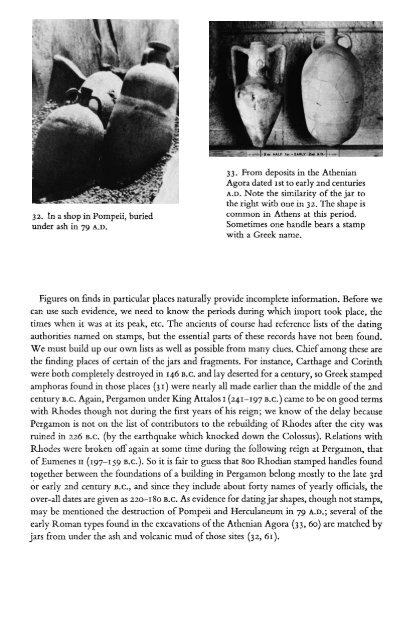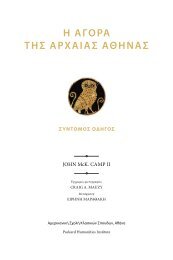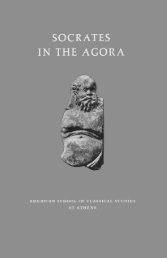You also want an ePaper? Increase the reach of your titles
YUMPU automatically turns print PDFs into web optimized ePapers that Google loves.
32. In a shop in Pompeii, buriedunder ash in 79 A.D.33. From deposits in the AthenianAgora dated 1st to early 2nd centuriesA.D. Note the similarity of the jar tothe right with one in 32. The shape iscommon in Athens at this period.Sometimes one handle bears a stampwith a Greek name.Figures on finds in particular places naturally provide incomplete information. Before wecan use such evidence, we need to know the periods during which import took place, thetimes when it was at its peak, etc. The ancients of course had reference lists of the datingauthorities named on stamps, but the essential parts of these records have not been found.We must build up our own lists as well as possible from many clues. Chief among these arethe finding places of certain of the jars and fragments. For instance, Carthage and Corinthwere both completely destroyed in 146 B.C. and lay deserted for a century, so Greek stampedamphoras found in those places (3 I) were nearly all made earlier than the middle of the 2ndcentury B.C. Again, Pergamon under King Attalos I (241-197 B.c.) came to be on good termswith Rhodes though not during the first years of his reign; we know of the delay becausePergamon is not on the list of contributors to the rebuilding of Rhodes after the city wasruined in 226 B.C. (by the earthquake which knocked down the Colossus). Relations withRhodes were broken off again at some time during the following reign at Pergamon, thatof Eumenes 11 (197-159 B.c.). So it is fair to guess that 800 Rhodian stamped handles foundtogether between the foundations of a building in Pergamon belong mostly to the late 3rdor early and century B.c., and since they include about forty names of yearly officials, theover-all dates are given as 220-180 B.C. As evidence for dating jar shapes, though not stamps,may be mentioned the destruction of Pompeii and Herculaneum in 79 A.D.; several of theearly Roman types found in the excavations of the Athenian Agora (33,60) are matched byjars from under the ash and volcanic mud of those sites (32, 61).











